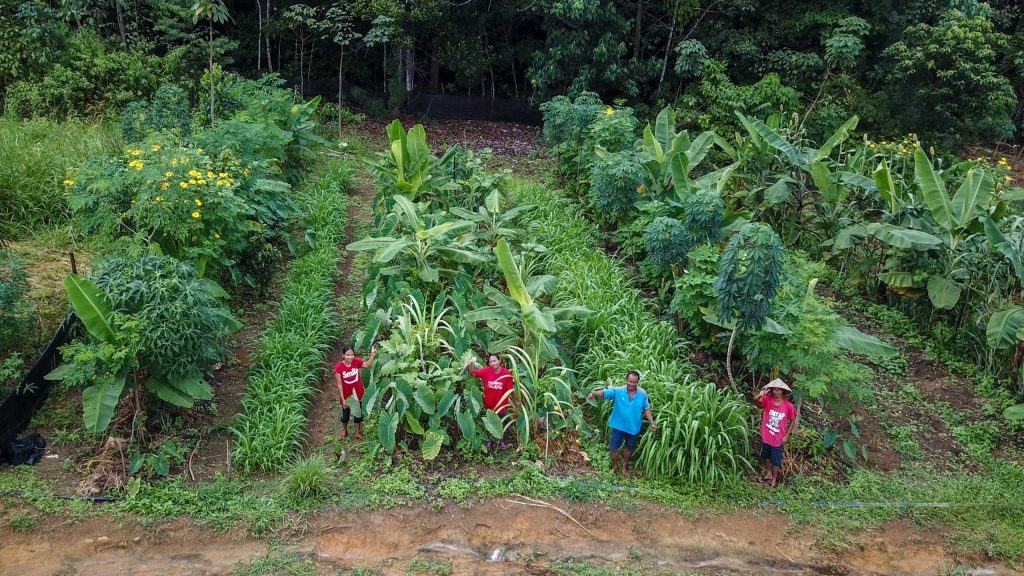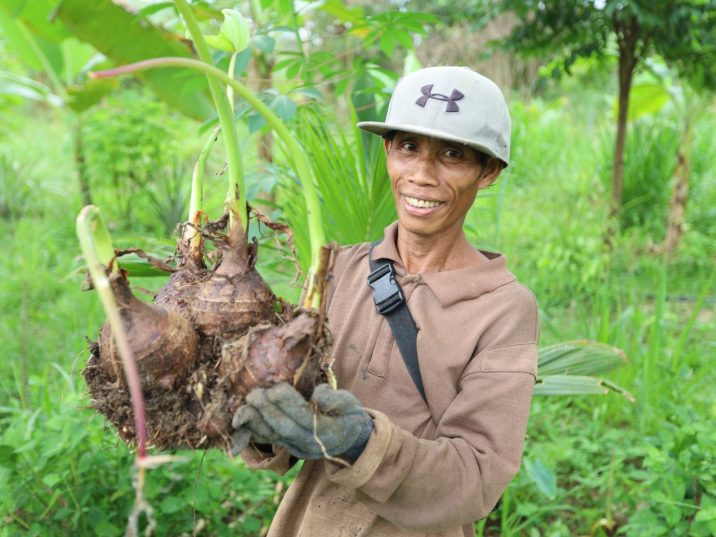
Why is Regenerative Agriculture needed ?
Regenerative agriculture is a comprehensive practice that restores ecosystems and boosts productivity, offering a crucial solution. With methods differing from those of conventional agriculture, regenerative farming techniques like syntropic farming and organic farming align with the traditional knowledge of the Orang Asli, enhancing biodiversity and enhancing soil health. By using these practices, they can halt land loss, achieve stable yields, and sustain their strong affinity for the forest. Additionally, regenerative agriculture creates economic opportunities through markets for organic and heritage crops, empowering communities as they protect their ancestral lands.
To achieve these benefits, facilitative policies and programs are essential. Regenerative practices must be integrated with traditional knowledge through training programs, ensuring sustainable food systems. Syntropic farming and organic farming initiatives can rehabilitate degraded land, while community-led ecotourism can generate revenue by promoting sustainable farming. With regenerative agriculture, Orang Asli can build resilience against ecological and economic shocks, maintaining their livelihoods for future generations.
Regenerative agriculture
What is regenerative agriculture?
Regenerative agriculture is an agricultural practice that aims to restore ecosystems in addition to producing food. It uses processes like cover cropping, minimum tillage, and agroforestry to enrich soil health, diversity, and hydrology. Regenerative agriculture combats climate change through carbon sequestration, increases resilience on farms, and promotes long-term sustainability by reducing dependence on chemical inputs, preventing soil moisture degradation, and integrating agriculture with the environment.
Regenerative agriculture is a new form of agriculture that views farms as living systems in themselves, and the interconnectedness of food systems, ecosystems, and reducing soil erosion . It uses methods like rotational grazing, syntropic farming, and native land stewardship to heal landscapes and reduce social and economic inequalities. Regenerative agriculture aims to make the world a better place for future generations, demonstrating that agriculture can be a regenerative force rather than an extractive one.
What are regenerative agriculture’s guiding ideas and methods?
Regenerative agriculture, a sustainable approach, aims to repair ecosystems while cultivating food, placing a focus on soil health for climate mitigation, water conservation, and food security. It captures Indigenous wisdom and treats farms as a part of nature. Some main ideas are lowering soil microbes disturbance, maintaining ground cover, adding biodiversity, and building closed-loop systems to reduce waste. This aligns with our vision of promoting harmony among people and the world, particularly through projects that empower rural and indigenous communities with sustainable agriculture practices.
Our initiatives promote regenerative agriculture, using pragmatic approaches like agroforestry, no-till farming, and cover cropping to restore degraded land and sequester carbon. These techniques are particularly beneficial in Malaysia’s tropical climates. Community-based approaches like natural pest management training and composting reduce reliance on chemical inputs. These approaches not only maintain ecological balance but contribute to peace building by generating sustainable livelihoods, preserving cultural heritage, and fostering cooperation between communities and ecosystems. By connecting traditional knowledge with regenerative practices, our demonstrates how agriculture can promote healing in the environment and social harmony.
Goals of Regenerative Agriculture
Regenerative agriculture is a groundbreaking new approach to farming that is perfectly in line with our goal of environmental sustainability and sustainable community development. Its basic objectives are:
Restore and Improve Soil Health
- By implementing practices like no-till or minimal-till farming, composting, and cover cropping, regenerative agriculture revives exhausted soils. A primary area of concern in Malaysia, where deforestation and monoculture farming have devastated fertile land.
- We encourage this through training programs that teach farmers to replenish soil organic matter, enhancing water retention and crop resilience.
Increase Biodiversity and Ecosystem Resilience
- Agroforestry, polyculture, and native species integration practices mimic natural ecosystems, fostering wildlife habitats and reducing pest outbreaks.
- This aligns with our community-based conservation efforts that empower indigenous groups such as the Orang Asli to preserve traditional, biodiversity-rich farming systems.
Reduce Reliance on Synthetic Inputs
- By replacing chemical fertilizers and pesticides with natural alternatives (e.g., compost and crop rotation), regenerative agriculture saves money and prevents water pollution.
- We promote these kinds of practices to improve food sovereignty, especially for rural communities vulnerable to market fluctuations.
Increase Carbon Absorption
- Healthy soils are carbon sinks, slowing climate change. A key principle of our environmental action.
- Schemes like reforestation and agro-ecological training directly tackle Malaysia’s climate goals while maintaining livelihoods.
Such goals render regenerative agriculture a tool for peace, bridging ecological restoration and social equity. Our vision is to unite farmers, scientists, and policymakers in sustainable action.
Key Principles of Regenerative Agriculture
5 Principles of Regenerative Agriculture
Regenerative agriculture is built on five core principles that form the conceptual foundation for sustainable land stewardship. These principles guide farming practices while aligning with our mission of ecological balance and community resilience:
1. Soil Health Improvement
- Focuses on rebuilding organic matter and microbial life through composting, reduced tillage, and organic amendments.
- Our Connection: Their training programs teach farmers soil regeneration techniques to combat degradation caused by deforestation and industrial agriculture in Malaysia.
2. Year-Round Ground Cover
- Uses cover crops, mulching, and agroforestry to protect soil from erosion, retain moisture, and suppress weeds naturally.
- Our Connection: Promotes these practices among rural communities to adapt to climate extremes while reducing reliance on chemical herbicides.
3. Biodiversity Enhancement
- Encourages polycultures, native species, and habitat restoration to create resilient ecosystems.
- Our Connection: Supports indigenous farming knowledge, such as the Orang Asli’s traditional agroforestry systems, which naturally boost biodiversity.
4. Reduced Synthetic Inputs
- Replaces chemical fertilizers/pesticides with compost, biochar, and biological pest control.
- Our Connection: Advocates for chemical-free farming to protect water sources and farmer health, key to sustainable rural development.
5. Livestock Integration
- Implements rotational grazing to recycle nutrients, improve soil fertility, and sequester carbon.
- Our Connection: Pilots integrated crop-livestock systems to help smallholders diversify income while regenerating land.
These principles reflect our holistic approach, where ecological restoration goes hand-in-hand with food security, cultural preservation, and climate action. By adopting these practices, Malaysian farmers can cultivate productive, climate-resilient landscapes that align with both global sustainability goals and local community needs.
Regenerative Agriculture Techniques
Regenerative agriculture transforms principles into action through proven techniques that restore ecosystems while supporting farmer livelihoods. These methods align with our mission to create sustainable, peaceful communities through ecological stewardship:
1. Syntrophic Farming


- Technique: Mimics natural forest succession by planting complementary species in dense, layered systems that thrive on symbiotic relationships
- Impact: Creates self-fertilizing ecosystems, accelerates soil regeneration, and yields diverse harvests from canopy to root zone
- Global Peace Link: Piloting syntrophic models in Orang Asli communities to restore degraded rainforest areas while providing food security
2. No-Till Farming & Cover Cropping
- Enhanced Approach: Combining no-till with syntrophic principles by using diverse cover crop mixes that create beneficial plant synergies
- Impact: Builds soil 3x faster than conventional no-till while suppressing weeds naturally
- Global Peace Link: Training farmers in polyculture cover cropping systems adapted to Malaysian climates
3. Syntrophic Crop Rotation
- Technique: Designing crop sequences where each plant prepares the soil for the next through root exudates and biomass
- Impact: Eliminates need for fallow periods, continuously improves soil conservation, and increases yields over time
- Global Peace Link: Integrated into market garden programs for urban fringe farmers
4. Holistic Syntrophic Grazing
- Technique: Combining rotational grazing with strategically planted fodder forests and medicinal herbs
- Impact: Creates complete nutrient cycles where animals and plants mutually enhance each other
- Global Peace Link: Developing integrated syntrophic farms as demonstration sites
Why Syntrophic Methods Matter for Malaysia:
These cutting-edge techniques align perfectly with our focus on:
- Rainforest restoration through productive agroforestry
- Climate resilience via ultra-efficient carbon sequestration
- Indigenous knowledge preservation by validating traditional polyculture wisdom
- Economic empowerment through diverse, year-round yields
We are uniquely positioned to bring these next-generation regenerative agricultural practices techniques to Malaysian farmers while maintaining cultural appropriateness and ecological sensitivity.
Benefits of Regenerative Agriculture

Environmental Impact
Regenerative farming is a sustainable approach to address environmental challenges faced by Orang Asli lands, such as deforestation and climate change. It involves no-till farming and composting practices, which improve soil health and water security. Syntrophic and agroforestry systems are particularly effective, sequestering carbon 3-5 times more than conventional agricultural methods. These practices also help recover endangered plant species, which are the foundation of Orang Asli diet and medicine, and safeguard natural and cultural heritage. This aligns with Malaysia’s climate commitments.
Social Benefits
Regenerative agriculture benefits Orang Asli food sovereignty and cultural resilience by eliminating chemical inputs and providing access to nutrient-rich traditional food sources like forest tubers, wild-harvested edibles, and medicinal plants. These systems also offer exceptional climate adaptation benefits, with polyculture farms being 60% more resilient to crop loss during extreme climates. Regenerative practices create an intergenerational bridge by combining traditional knowledge with contemporary ecological principles, engaging youth in protecting and advancing traditional practices. Economically, regenerative agriculture leads to 30-50% income increases for beneficiary communities, ending dependency on external food systems while maintaining cultural heritage.
How to Support Our Regenerative Agriculture Effort
Consumer Choices: Vote with Your Wallet
- Purchase directly from Orang Asli regenerative farms (e.g., native rice, forest honey, organic herbs)
- Choose brands that partner with indigenous regenerative producers
- Join CSA (Community-Supported Agriculture) programs to sustain smallholder farmers
Policy Support: Create an Enabling Environment
- Advocate for land rights to secure Orang Asli territories for regenerative farming
- Push for subsidies to transition from chemical to regenerative farming practices
- Support policies that recognize agroecology in Malaysia’s climate action plans
Farmer Education: Build Knowledge & Capacity
- Fund training corporate social responsibility programs in syntrophic agroforestry & soil regeneration
- Develop digital tools to share regenerative agriculture practices in local languages
- Establish mentor networks connecting experienced and new regenerative farmers
Conclusion
Our regenerative agriculture project offers a game-changing solution that not only reduces carbon emissions, but actively contributes towards reversing environmental degradation through enhanced carbon sequestration.
We help orang asli transition from customary practice to sustainable land use practice that emphasizes plant diversity and soil fertility. Orang Asli embrace regenerative practices like utilizing natural fertilizers and increasing organic matter, with the assurance of productive crop yields and the production of more nutritious food. Our approach promotes healthy plant growth for a diverse range of food crops, protecting native plant species that are vital to Malaysia’s biodiversity.
At Global Peace Malaysia, we’re committed to promoting regenerative practices that:
- Restore soil health
- Maintain agricultural productivity through sustainable farming practices
- Protect Malaysia’s rich biodiversity through sustainable agriculture
Join us in transforming Malaysia’s agricultural future for Orang Asli. Visit our Regenerative Farming program page to learn how you can support this vital work.
Join Us Now to increase regenerative Agriculture efforts
“Every ringgit spent on regenerative food is an investment in clean water, climate stability, and cultural preservation.”






